Last Updated February 14, 2025 (originally published July 2, 2015)
|
Key Takeaways This blog offers a woman’s guide to gaining muscle, complete with a summary of key principles and a sample muscle-building workout. More and more women are lifting weights to meet their health, fitness and performance goals, so understanding how to safely build muscle through weightlifting is vital. If you’re looking for the best exercises for women to build muscle, look no further. Key ideas include lifting heavy weights and selecting the right exercises, as well as the sets, reps and recovery times that will help you meet your goals. |
Many women have traditionally avoided weightlifting because of the common misconception that it will make them “get big.” Fortunately, the power of this myth seems to be fading, as more and more women are turning to weightlifting as a means of improving their strength, balance and overall well-being. In 2004, only 17.5% of women in the United States participated in strength training two or more times per week. Fast-forward 16 years, and in 2020 it was reported that 26.9% of women met the guidelines for muscle-strengthening physical activity.
So, let’s turn this myth on its head and talk about how women who have a goal of gaining muscle can do so safely and effectively through resistance training.
Before we get into the “how” of weight training, let’s look at some proven principles and clear up some misconceptions.
1. Lifting Heavy
To stimulate muscle growth, or hypertrophy, a stimulus must be placed on the muscle. Some women, in response to a fear of “getting big,” tend to stick with weights that they are comfortable using for a full three sets. However, a greater stimulus must be placed on the muscles to see any real changes. You need to get out of your comfort zone using appropriate load progressions and put greater physiological demands on your muscles. Once you can make this paradigm shift in your mind, you will be able to make substantial progress in both your strength and muscle gains. Generally, it is recommended to increase your load in 5% increments until the weights are heavy enough to complete each set within the goal repetition range. For example, if you currently bench press 10 repetitions using 100 pounds (45 kg), increase to 105 pounds (48 kg) to see if this decreases the number of repetitions you can perform. If you can still complete 10 repetitions on your next set, add another 5 pounds (2.3 kg).
Women often underestimate their strength and, by default, grab lighter weights. This is a mistake. Instead, choose a weight that can be lifted 10 times, with the last two repetitions posing a significant challenge. It is important to maintain good form throughout the set, so as soon as you notice your form starting to fail, reduce the amount of weight being lifted or take a rest. The goal is to lift heavy and well, not lift heavy and get hurt. Be sure to have a spotter when performing exercises such as a back squat, bench press and overhead press, especially when learning a new exercise or going up in weight.
2. Sets and Reps
The typical recommendation for building muscle is to complete three to six sets of six to 12 reps of an exercise. If you choose a heavier weight and do fewer repetitions (e.g., three to six), you’re more likely to gain muscular strength, while using lighter weights and higher repetitions lead to gains in muscular endurance. If you’re aiming for greater strength, take a little extra rest time between sets (2 to 5 minutes). If your primary goal is to increase muscle size, reduce the amount of rest you take between sets (30 to 90 seconds).
3. Frequency.
One of the most important elements of achieving muscle gains is consistency, so aim to weight train four to five days a week, if possible. Recording your exercises and weights in a journal is a great way to track gains. You can have good intentions to lift heavy, but the only way to know if you are getting stronger is by writing down the sets, reps and weights used during each workout. Another thing to consider is the breakdown of your weight-training sessions. Will you perform total-body workouts or focus exclusively on upper- or lower-body exercises? Or maybe two body parts per workout? Whatever you end up deciding, the key is consistency and overload.
4. Exercise Selection
There are countless ways to create a workout to gain muscle mass. Ideally, perform exercises requiring larger muscle groups first, such as squat/squat variations, bench press, deadlifts, lat pull-downs and overhead press. Doing so enables you to expend greater energy on these movements, while still being able to perform well on movements involving smaller muscles/muscle groups toward the end of your workout. Choose six to eight exercises to perform on any given day. You can split them up into circuits or do them separately, utilizing rest periods between sets that are specific to your training goals.
Sample Muscle-building Exercises
As mentioned above, stimulating muscle growth happens when muscles are pushed beyond their comfort zones. Be sure to include some of these movements in your workouts to maximize your muscle hypertrophy. To further explore proper form and variations for the exercises below, visit the ACE Exercise Library, which features step-by-step instructions for each movement.
Squat
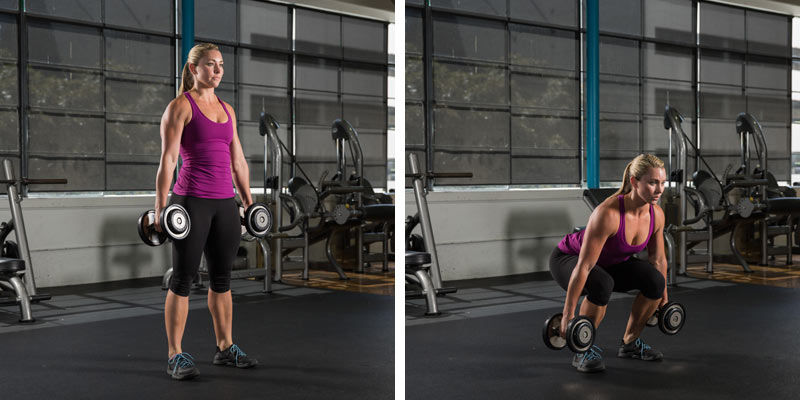
Whether you choose heavy dumbbells, a barbell or the squat rack, this exercise is great for shaping and building muscle in your quads and glutes. Maintaining proper form is key, so gradually add weight as you train while maintaining good form. Ideally, when you look into the mirror, you should pretend you are sitting in a chair at the bottom of your squat, with your heels on the ground and hips back.
Shoulder Press

There are a number of shoulder-press variations, including the dumbbell press, Arnold press and behind-the-neck press. These exercises are great for the shoulders, traps and upper body. Don’t be afraid to add some weight and be sure to have a spotter if you are really pushing yourself.
Deadlift
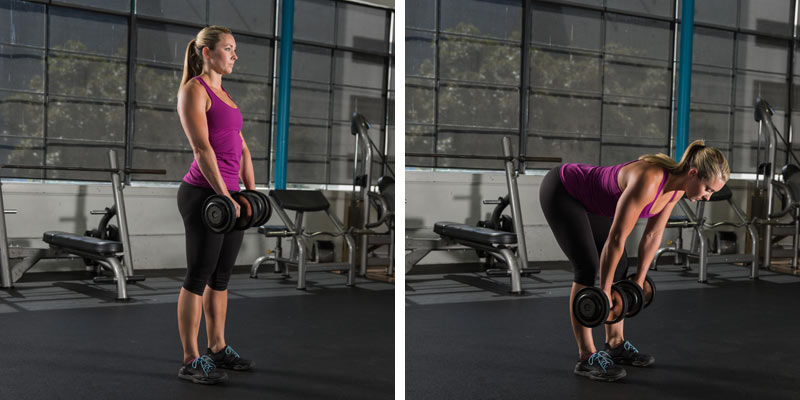
Whether you choose the single-leg or traditional deadlift, using dumbbells or barbells, this versatile exercise engages the hamstrings, glutes and back muscles. Form is critical on this exercise, so be sure to keep a flat back and slight bend in your knees. If you feel your back rounding, reduce the weight and refocus on your form.
Chest Press
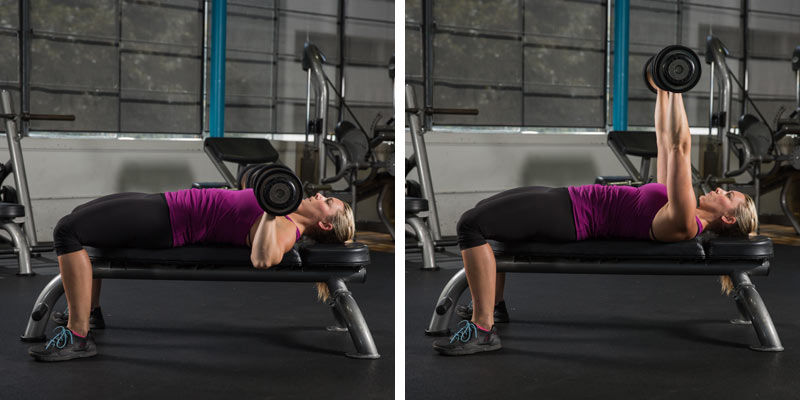
There are myriad ways to perform a chest press, including on an incline, decline, flat bench or the floor, each of which will target the chest from different angles. Dumbbells or a barbell can be used, and if you are really pushing your upper limit, be sure to have a spotter.
Biceps curls
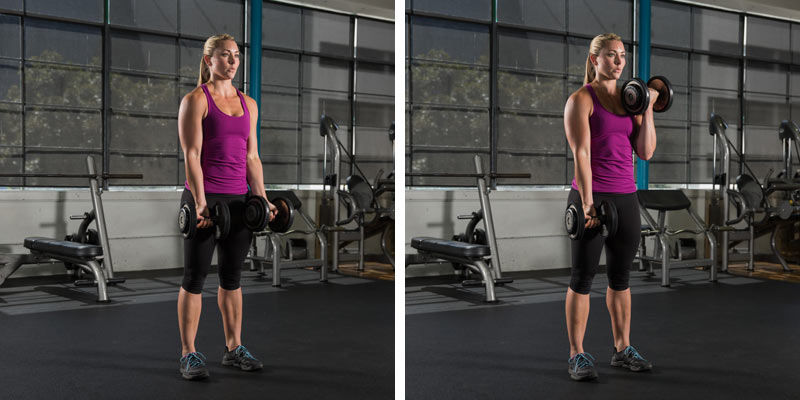
Although a smaller muscle group, the biceps can lift some heavier weight when pushed. Incorporate a few curl variations into your program, such as barbell curls, dumbbell seated curls, hammer curls or rope curls. Be sure not to rock for momentum and if you feel your back starting to arch, it’s time to lower the weight.
Triceps Kickback
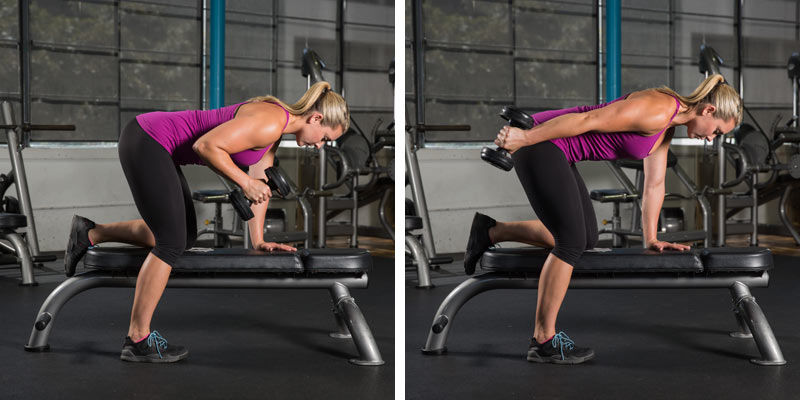
Show off that “horseshoe” by sculpting the triceps. Start with your upper arm parallel to the floor and bend the elbow until your forearm is perpendicular to the floor. Then, contract your triceps until your elbow is fully extended. Remember to keep momentum out of the equation to truly isolate the triceps and shape those arms.
If you’re interested in providing a more holistic approach to improving your female clients’ fitness regimen and overall health, check out Strategies for Training Female Clients – Course Bundle (worth 0.4 ACE CECs). The following courses are included in this bundle:
- Weightlifting for Women
- Training Female Clients Through Different Life Stages
- Training Women for Optimal Health and Performance




 by
by 



 by
by